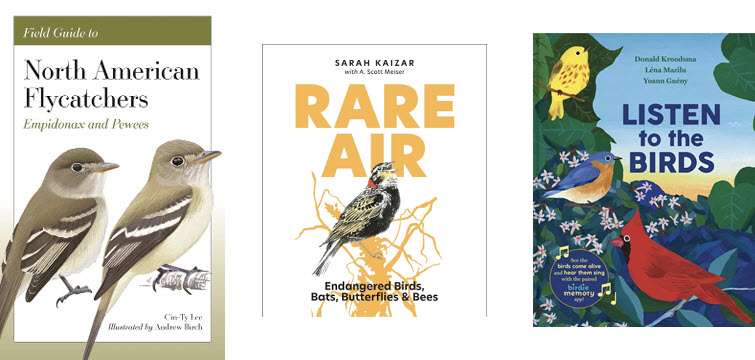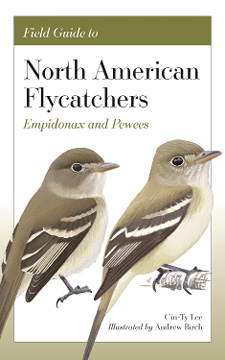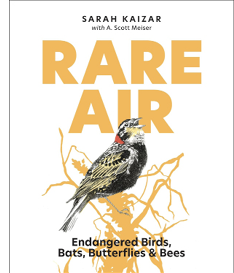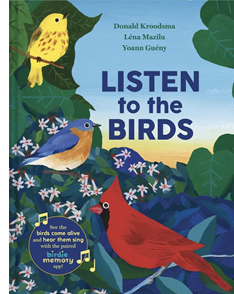Mark Lynch

Field Guide to North American Flycatchers: Empidonax and Pewees
Cin-Ty Lee, illustrated by Andrew Birch. 2023. Princeton University Press: Princeton, New Jersey.
Rare Air: Endangered Birds, Bats, Butterflies, & Bees
Sarah Kaizar with A. Scott Meiser. 2023. Mountaineers Books (Skipstone imprint): Seattle, Washington.
Listen to the Birds
Donald Kroodsma, Léna Mazilu, Yoann Guény. 2023. W. W. Norton & Company, Inc. New York, N.Y.
The relationship between writers and the illustrators of their writing is a varied and complex one. Sometimes the writer and illustrator of a book are the same person. Thomas Bewick, Roger Tory Peterson, David Sibley, and Lars Jonsson are all well-known authors who illustrated their published works.
Some authors’ books are as remembered for the artists that illustrated them. I will always consider Sir John Tenniel’s illustrations for Lewis Carroll’s Alice books to be the definitive visual interpretation of those classics. Though many other artists since have attempted to illustrate Carroll’s books, most fall short of the detailed Victorian charm of Tenniel’s work. A.A. Milne’s Winnie the Pooh stories are intimately connected in the reader’s imagination with the gentle and minimal drawings of E. H. Shepard. Who could imagine reading Hunter Thompson’s gonzo classic Fear and Loathing in Las Vegas without Ralph Steadman’s frenetic explosive artwork? In many cases, the author and artist knew each other before working on the book.
At other times, an illustrator is assigned to create visualizations for an author that they may not be familiar with. Sometimes an author will request a specific artist to do the illustrations, but many times today, who illustrates what book is a decision by the publisher. Well-known artists may illustrate a book by a long dead author. Gustave Doré made a career out of creating dramatic illustrations for works including “The Divine Comedy”, Orlando, and “The Rime of the Ancient Mariner.” Rockwell Kent’s noteworthy illustrations for Moby Dick are a perfect dramatic accompaniment to Melville’s singularly strange tome about an albino cetacean. In these cases, the artist’s illustrations can be appreciated separately from the text as works of art.
Below I discuss three books that represent three different relationships between writer and artist.
 Cin-Ty Lee is a professor in the Department of Earth, Environmental, and Planetary Sciences at Rice University. If you are a long-time birder in Massachusetts, you may remember him as a birder in the area. Andrew Birch is an illustrator of many bird identification articles and books. Birch and Lee have known each other for decades, and their joint passion has been the field identification of hard-to-identify species.
Cin-Ty Lee is a professor in the Department of Earth, Environmental, and Planetary Sciences at Rice University. If you are a long-time birder in Massachusetts, you may remember him as a birder in the area. Andrew Birch is an illustrator of many bird identification articles and books. Birch and Lee have known each other for decades, and their joint passion has been the field identification of hard-to-identify species.
This book is the product of a lifelong dream to tackle the identification of some of the most challenging groups in field identification. The two of us met at Berkeley in the early 1990s when we were college students. Together, we worked on a variety of short identification articles focused on advanced topics for various birding magazines. The most satisfying topics were identification challenges that required a more holistic approach, not just focusing on plumage features, but also looking at overall structure, shape, size, and impression. (p. 1 Field Guide to North American Flycatchers)
Non-calling Empidonax flycatchers and pewees are among the most consistently difficult birds to separate in the field. This small guide (157 pages) pulls together as much information that the two authors could find about identification combined with both author’s considerable field experience. Each species has a number of painted plates, including useful comparison pages of similar species. There are eight pages alone comparing Hammond’s, Dusky, Gray, and Least Flycatchers (p. 122–129). Unlike most field guides, the plates are not crowded and the range maps are large and detailed with information about the migration and breeding ranges of each species. There are paragraphs on calls and songs that include large sonograms. Species include real rarities in America such as the Pine Flycatcher of Mexico, a species that at the date of publication had only two records in the States.
The authors go deep into sorting through useful physical characteristics, describing and illustrating the different crown shapes, forehead angles, bill lengths, lower mandible colors, and relative tail lengths and widths. The reader will learn that wing panel contrast between the secondary panel and primary panel can be a useful clue in separating some species. Primary extension is another characteristic to look at when confronted with a non-singing individual. Regionally, the Acadian Flycatcher has the longest primary extension. Is the eye ring teardrop shaped, crisp, messy, or indistinct? Some of these visual differences are subtle, even in the illustrations.
There may be a lot of subtle field marks to look for, but that is what is necessary to clinch a field identification. A useful graph that the authors include is what they label a “field mark matrix.” (p. 43) You can tick off what you noticed in the field on this Excel-like diagram that has species names listed on the x-axis and field marks on the y-axis. There is even a “visual similarity map” (p. 44) that maps how similar each species is to the other species. This method sounds odd, but I found it useful.
The Field Guide to North American Flycatchers: Empidonax and Pewees is an interesting field guide. You get the feeling the authors were so excited by the thought of completing this project that they put in everything they have learned about this difficult to identify group of birds. The authors write that they were inspired by the field guides of Kenn Kaufman, David Sibley, and Lars Jonsson. They also mention that the field guides of Osao Ujihara and Michiaki Ujihara were “truly inspirational” (p. 2)—these two Japanese authors and illustrators have produced identification guides and plates on gulls and shorebirds. Birch’s illustrations for the Field Guide to North American Flycatchers are superb.
The Field Guide to North American Flycatchers is not a “field guide” in the sense that you would carry it around with you. But you might keep a copy in your car. Better yet, get what photos you can of that non-calling empid and, at home, compare your shots with the numerous illustrations in this guide. I know that Cin-Ty Lee and Andrew Birch are hoping to create other guides to species that are difficult to identify. I hope so. This book is a case of an author and illustrator who are friends and have worked together several times before, combining their talents to produce a unique guide.
 “This book invites you to look up.” (p. 6 Rare Air)
“This book invites you to look up.” (p. 6 Rare Air)
Rare Air is a unique book propelled by Sarah Kaizar’s artwork. She is an artist and illustrator who lives in Philadelphia. Her artwork has been displayed in several galleries and museums. A. Scott Meiser is a high school English teacher with a deep love of the natural world. His role in Rare Air is not clear, but it appears he did some of the research for the written sections of the book.
All the species described in Rare Air fly. There are 33 species or sub-species of birds, 16 species of butterflies, 12 species of bees, and 5 species of bats. Most species accounts feature at least one full page illustration combined with an essay on what challenges these species face. There are several two-page spreads, usually of birds in flight. Some chapters describe multiple species, such as the chapter on bumblebees (p. 66–71) or the endangered butterflies of California (p. 94–103). In these chapters, several illustrations are included. There are also four long essays titled “Field Feature.” These essays are deeper dives describing profiles of biologists and researchers working in the field and notable conservation projects that can be based on “citizen science.” An example would be participating in a “Nurdle Patrol” (p. 80–3) by walking beaches and mapping plastics in the wrack.
Sarah Kaizar has long created artwork that is conservation driven. This obsession started as a way of dealing with a turbulent life.
Drawing endangered species started as a straightforward project, bringing together my loves of the outdoors and for all animals. Then it tipped into obsession. I was experiencing serious turbulence within my family and personal relationships after college. These things felt separate at the time; problems at home seemed different from the compulsive cataloging and illustrating of species that I had taken upon myself. Looking back, however, it’s clear to me that it was easier—and more productive—to pivot my attention to the vulnerabilities of, say, every endangered species of clam and mussel than to face the vulnerabilities within my family. (p. 6 Rare Air)
Subsequently she worked at a series of conservation organizations and became interested specifically in drawing flying species that were declining. Her list of species for Rare Air was gleaned from federally listed species as well as species listed in the International Union for Conservation of Nature’s (IUCN) “Red List” of threatened species. For each species, their federal status as well as their listing on the Red List are shown.
The bird species in Rare Air are an idiosyncratic list. There are obvious choices such as California Condor and Whooping Crane, but there are a number of endangered subspecies including Least Bell’s Vireo, San Clemente Loggerhead Shrike, and Masked Bobwhite. There are bird species from Hawaii and Puerto Rico. One bird in particular stands out as an odd choice: the Java Sparrow found in Hawaii. This bird is an introduced species that is seriously declining in much of its original habitat. How should Hawaiian conservationists deal with this bird when it could become extinct in the locations in Asia where it was native?
Kaizar’s drawings are detailed and realistic with minimal use of color, often on the species or as part of the minimal background. I would be interested to see these works displayed in a museum gallery. Much of this project was created during the Covid epidemic so she had to rely on photographs as visual source material. The written sections contain information that may be new to even hardcore birders. Under the section on Evening Grosbeaks (132-3) you learn that a group of grosbeaks is called a charm:
A bird species of 3.4 million mature adults may not seem as “vulnerable” as the IUCN prescribes, but according to them, this number represents as much as a 94 percent decrease in the last fifty years. The main reasons for the evening grosbeak’s sharp decline remains unclear. They are the tenth most reported species to die from window collisions, which can be avoided, for the most part, by using window screens and bird-friendly decals. Others of these finches meet their fate on roads and highways, nibbling at the gravel for nutritious minerals. Once its primary threats are determined, conservationists will be better able to protect these puckish charms from undue harm. (p. 132 Rare Air)
Rare Air is a unique and personal look at endangered species, how they became endangered, and what can be done to bring their populations back to sustainable levels. This book is worth owning for both its written content and its fine artwork. Even the publisher is an independent not-for-profit organization.
 “For children of all ages, that they may appreciate the magic of birdsong.” (dedication to Listen to the Birds)
“For children of all ages, that they may appreciate the magic of birdsong.” (dedication to Listen to the Birds)
Here in the twenty-first century, some books are no longer credited to just writers and artists. Take Listen to the Birds. The author is Donald Kroodsma, world renowned authority on bird song and professor emeritus of ornithology at the University of Massachusetts Amherst. He has written a number of important and entertaining books on bird song. For me, just listening to Donald Kroodsma talk about bird song is one of the great birding experiences. He is also one of the first natural history authors to use QR (quick response) codes in his books to great effect.
Léna Mazilu is an illustrator and designer. She is passionate about birds, nature, and education. She lives in Brittany. Yoann Guény is an “interactive developer” who specializes in “online experiences and augmented reality.” He is from Paris. Léna Mazilu has previously published other “augmented reality” books. Guény and Mazilu together developed the Birdie Memory app used in Listen to the Birds. Some books today now credit an author, an artist, and a tech designer.
Listen to the Birds is a book for young readers, introducing them to the songs of common birds in habitats around them. There are an Eastern and Western section of this colorful book. The pages take the reader on an imaginary walk through woods and fields and point out the birds that can be found there. Each leg of the walk has a written introduction:
The forest beckons: big, beautiful oaks, maples, and hickory trees. Our path will take us through the woods and across a stream, then past a pond, and through more edge habitat before returning to the park where we began. (p. 13 Listen to the Birds)
The bird species are common ones, such as cardinal and towhee, but also include Western Tanager and Anna’s Hummingbird. There are several paragraphs written about each species, including a description of their song. Habitats include forest, a park at the edge of town, open meadows, and more.
Now here’s the surprise of Listen to the Birds. If you first download the Birdie Memory app and then hold your phone over a bird picture in the book, not only will you hear that bird sing, but on your phone screen you will see the drawing move as it sings. It is a simple animation but it is captivating. The book comes alive. You can also use this app to first listen to a bird song from a species in the book, and then to test what you have learned, point the phone at the picture you think is the species singing and you will find out if you are right.
The amount of information in Listen to the Birds is amazing. He writes about why birds sing and introduces the young reader to technical terms like “counter singing.” There is even an introduction to reading spectrograms of song. The written content amounts to a young person’s introductory course on bird vocalization. Every primary school classroom that has a natural history section would find this book useful and would encourage the teacher and students to keep track of bird song around the school.
Mazilu’s bird art is basic and simple but colorful. Backgrounds are likewise basic. I find her birds a bit too “zaftig,” but that is my personal taste. As a wee tyke I was enamored by the sharply defined and detailed look of Sir John Tenniel’s work. Mazilu does have a tendency to include eye rings on species that don’t have them—for example the Common Raven—perhaps to highlight where the eye is on the head. This book is about song and not field identification, after all.
Listen to the Birds is a fun book that teaches the young reader the science of bird song, where it can be heard, and what song can mean. Parents will enjoy reading this book with their children and then taking a spring walk to listen for the songs they learned. It will be interesting to see if this technology can be applied to adult books on the natural world.
To listen to Mark Lynch’s conversations with some of the artists and writers of these books, please go to:
Cin-Ty Lee and Andrew Birch: https://wicn.org/podcast/cin-ty-lee-and-andrew-birch/
Sarah Kaizar: https://wicn.org/podcast/sarah-kaisar/
Donald Kroodsma and Léna Mazilu: https://wicn.org/podcast/donald-kroodsma-lena-mazilu/